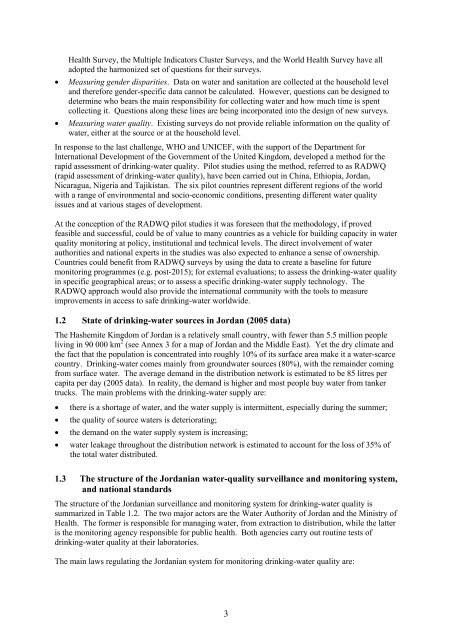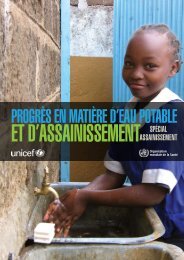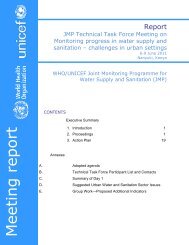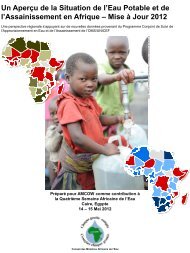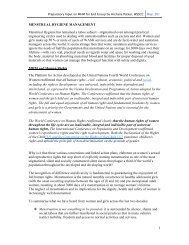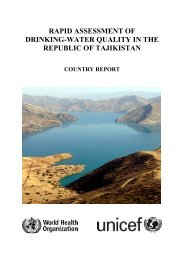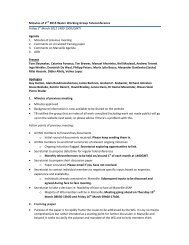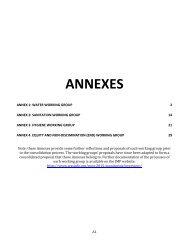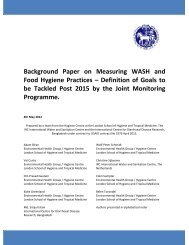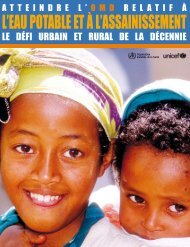Rapid assessment of drinking-water quality in the - WHO/UNICEF ...
Rapid assessment of drinking-water quality in the - WHO/UNICEF ...
Rapid assessment of drinking-water quality in the - WHO/UNICEF ...
Create successful ePaper yourself
Turn your PDF publications into a flip-book with our unique Google optimized e-Paper software.
Health Survey, <strong>the</strong> Multiple Indicators Cluster Surveys, and <strong>the</strong> World Health Survey have all<br />
adopted <strong>the</strong> harmonized set <strong>of</strong> questions for <strong>the</strong>ir surveys.<br />
Measur<strong>in</strong>g gender disparities. Data on <strong>water</strong> and sanitation are collected at <strong>the</strong> household level<br />
and <strong>the</strong>refore gender-specific data cannot be calculated. However, questions can be designed to<br />
determ<strong>in</strong>e who bears <strong>the</strong> ma<strong>in</strong> responsibility for collect<strong>in</strong>g <strong>water</strong> and how much time is spent<br />
collect<strong>in</strong>g it. Questions along <strong>the</strong>se l<strong>in</strong>es are be<strong>in</strong>g <strong>in</strong>corporated <strong>in</strong>to <strong>the</strong> design <strong>of</strong> new surveys.<br />
Measur<strong>in</strong>g <strong>water</strong> <strong>quality</strong>. Exist<strong>in</strong>g surveys do not provide reliable <strong>in</strong>formation on <strong>the</strong> <strong>quality</strong> <strong>of</strong><br />
<strong>water</strong>, ei<strong>the</strong>r at <strong>the</strong> source or at <strong>the</strong> household level.<br />
In response to <strong>the</strong> last challenge, <strong>WHO</strong> and <strong>UNICEF</strong>, with <strong>the</strong> support <strong>of</strong> <strong>the</strong> Department for<br />
International Development <strong>of</strong> <strong>the</strong> Government <strong>of</strong> <strong>the</strong> United K<strong>in</strong>gdom, developed a method for <strong>the</strong><br />
rapid <strong>assessment</strong> <strong>of</strong> <strong>dr<strong>in</strong>k<strong>in</strong>g</strong>-<strong>water</strong> <strong>quality</strong>. Pilot studies us<strong>in</strong>g <strong>the</strong> method, referred to as RADWQ<br />
(rapid <strong>assessment</strong> <strong>of</strong> <strong>dr<strong>in</strong>k<strong>in</strong>g</strong>-<strong>water</strong> <strong>quality</strong>), have been carried out <strong>in</strong> Ch<strong>in</strong>a, Ethiopia, Jordan,<br />
Nicaragua, Nigeria and Tajikistan. The six pilot countries represent different regions <strong>of</strong> <strong>the</strong> world<br />
with a range <strong>of</strong> environmental and socio-economic conditions, present<strong>in</strong>g different <strong>water</strong> <strong>quality</strong><br />
issues and at various stages <strong>of</strong> development.<br />
At <strong>the</strong> conception <strong>of</strong> <strong>the</strong> RADWQ pilot studies it was foreseen that <strong>the</strong> methodology, if proved<br />
feasible and successful, could be <strong>of</strong> value to many countries as a vehicle for build<strong>in</strong>g capacity <strong>in</strong> <strong>water</strong><br />
<strong>quality</strong> monitor<strong>in</strong>g at policy, <strong>in</strong>stitutional and technical levels. The direct <strong>in</strong>volvement <strong>of</strong> <strong>water</strong><br />
authorities and national experts <strong>in</strong> <strong>the</strong> studies was also expected to enhance a sense <strong>of</strong> ownership.<br />
Countries could benefit from RADWQ surveys by us<strong>in</strong>g <strong>the</strong> data to create a basel<strong>in</strong>e for future<br />
monitor<strong>in</strong>g programmes (e.g. post-2015); for external evaluations; to assess <strong>the</strong> <strong>dr<strong>in</strong>k<strong>in</strong>g</strong>-<strong>water</strong> <strong>quality</strong><br />
<strong>in</strong> specific geographical areas; or to assess a specific <strong>dr<strong>in</strong>k<strong>in</strong>g</strong>-<strong>water</strong> supply technology. The<br />
RADWQ approach would also provide <strong>the</strong> <strong>in</strong>ternational community with <strong>the</strong> tools to measure<br />
improvements <strong>in</strong> access to safe <strong>dr<strong>in</strong>k<strong>in</strong>g</strong>-<strong>water</strong> worldwide.<br />
1.2 State <strong>of</strong> <strong>dr<strong>in</strong>k<strong>in</strong>g</strong>-<strong>water</strong> sources <strong>in</strong> Jordan (2005 data)<br />
The Hashemite K<strong>in</strong>gdom <strong>of</strong> Jordan is a relatively small country, with fewer than 5.5 million people<br />
liv<strong>in</strong>g <strong>in</strong> 90 000 km 2 (see Annex 3 for a map <strong>of</strong> Jordan and <strong>the</strong> Middle East). Yet <strong>the</strong> dry climate and<br />
<strong>the</strong> fact that <strong>the</strong> population is concentrated <strong>in</strong>to roughly 10% <strong>of</strong> its surface area make it a <strong>water</strong>-scarce<br />
country. Dr<strong>in</strong>k<strong>in</strong>g-<strong>water</strong> comes ma<strong>in</strong>ly from ground<strong>water</strong> sources (80%), with <strong>the</strong> rema<strong>in</strong>der com<strong>in</strong>g<br />
from surface <strong>water</strong>. The average demand <strong>in</strong> <strong>the</strong> distribution network is estimated to be 85 litres per<br />
capita per day (2005 data). In reality, <strong>the</strong> demand is higher and most people buy <strong>water</strong> from tanker<br />
trucks. The ma<strong>in</strong> problems with <strong>the</strong> <strong>dr<strong>in</strong>k<strong>in</strong>g</strong>-<strong>water</strong> supply are:<br />
<br />
<br />
<br />
<br />
<strong>the</strong>re is a shortage <strong>of</strong> <strong>water</strong>, and <strong>the</strong> <strong>water</strong> supply is <strong>in</strong>termittent, especially dur<strong>in</strong>g <strong>the</strong> summer;<br />
<strong>the</strong> <strong>quality</strong> <strong>of</strong> source <strong>water</strong>s is deteriorat<strong>in</strong>g;<br />
<strong>the</strong> demand on <strong>the</strong> <strong>water</strong> supply system is <strong>in</strong>creas<strong>in</strong>g;<br />
<strong>water</strong> leakage throughout <strong>the</strong> distribution network is estimated to account for <strong>the</strong> loss <strong>of</strong> 35% <strong>of</strong><br />
<strong>the</strong> total <strong>water</strong> distributed.<br />
1.3 The structure <strong>of</strong> <strong>the</strong> Jordanian <strong>water</strong>-<strong>quality</strong> surveillance and monitor<strong>in</strong>g system,<br />
and national standards<br />
The structure <strong>of</strong> <strong>the</strong> Jordanian surveillance and monitor<strong>in</strong>g system for <strong>dr<strong>in</strong>k<strong>in</strong>g</strong>-<strong>water</strong> <strong>quality</strong> is<br />
summarized <strong>in</strong> Table 1.2. The two major actors are <strong>the</strong> Water Authority <strong>of</strong> Jordan and <strong>the</strong> M<strong>in</strong>istry <strong>of</strong><br />
Health. The former is responsible for manag<strong>in</strong>g <strong>water</strong>, from extraction to distribution, while <strong>the</strong> latter<br />
is <strong>the</strong> monitor<strong>in</strong>g agency responsible for public health. Both agencies carry out rout<strong>in</strong>e tests <strong>of</strong><br />
<strong>dr<strong>in</strong>k<strong>in</strong>g</strong>-<strong>water</strong> <strong>quality</strong> at <strong>the</strong>ir laboratories.<br />
The ma<strong>in</strong> laws regulat<strong>in</strong>g <strong>the</strong> Jordanian system for monitor<strong>in</strong>g <strong>dr<strong>in</strong>k<strong>in</strong>g</strong>-<strong>water</strong> <strong>quality</strong> are:<br />
3


